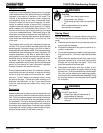
September 7, 2007
433-1390D
Page 47
7100FP EPA Woodburning Fireplace
R
Moisture content
Regardless of which species of wood you burn, the single
most important factor that affects the way your fi replace
operates is the amount of moisture in the wood. The
majority of the problems fi replace owners experience
are caused by trying to burn wet, unseasoned wood.
Freshly cut wood can be as much water as it is wood,
having a moisture content of around 50%. Imagine a
wooden bucket that weighs about 8 pounds. Fill it with a
gallon of water, put it in the fi rebox and try to burn it. This
sounds ridiculous but that is exactly what you are doing
if you burn unseasoned wood. Dead wood lying on the
forest fl oor should be considered wet, and requires full
seasoning time. Standing dead wood can be considered
to be about two-thirds seasoned, if cut at the dry time
of the year.
The problems with burning wet, unseasoned wood are
two fold. First, you will receive less heat output from wet
wood because it requires energy in the form of heat to
evaporate the water trapped inside. This is wasted energy
that should be used for heating your home. Secondly, this
moisture evaporates in the form of steam which has a
cooling effect in your fi rebox and chimney system. When
combined with tar and other organic vapors from burn-
ing wood it will form creosote which condenses in the
relatively cool fi rebox and chimney. See the maintenance
section of this manual for more information regarding
creosote formation and need for removal.
Even dry wood contains at least 15% moisture by weight,
and should be burned hot enough to keep the chimney
hot for as long as it takes to dry the wood out - about
one hour. To tell if wood is dry enough to burn, check
the ends of the logs. If there are cracks radiating in all
directions from the center, it is dry. If your wood sizzles
in the fi re, even though the surface is dry, it may not be
fully cured.
Seasoning
Seasoned fi rewood is nothing more than wood that is cut
to size, split and air dried to a moisture content of around
20%. The time it takes to season wood varies from around
nine months for soft woods to as long as eighteen months
for hardwoods. The key to seasoning wood is to be sure
it has been split, exposing the wet interior and increasing
the surface area of each piece. A tree that was cut down
a year ago and not split is likely to have almost as high a
moisture content now as it did when it was cut.
Fire Risk
• Do NOT burn wet or green wood.
• Store wood in dry location.
• Stack wood so both ends are exposed to
air.
Wet, unseasoned wood can cause
accumulation of creosote.
WARNING
Fire Risk
Do NOT store wood:
• Closer than required clearances to
combustibles to fi replace.
• Within space required for loading or ash
removal.
WARNING
Storing Wood
Splitting wood before it is stored reduces drying time.
The following guideline will ensure properly seasoned
wood:
a. Stack the wood to allow air to circulate freely around
and through the woodpile.
b. Elevate the woodpile off the ground to allow air cir-
culation underneath.
c. The smaller the pieces, the faster the drying process.
Any piece over 6 in. (152 mm) in diameter should be
split.
d. Wood should be stacked so that both ends of each
piece are exposed to air, since more drying occurs
through the cut ends than the sides. This is true
even with wood that has been split.
e. Store wood under cover, such as in a shed, or cov-
ered with a tarp, plastic, tar paper, sheets of scrap
plywood, etc., as uncovered wood can absorb water
from rain or snow, delaying the seasoning process.
Avoid covering the sides and ends completely. Doing
so may trap moisture from the ground and impede
air circulation.


















